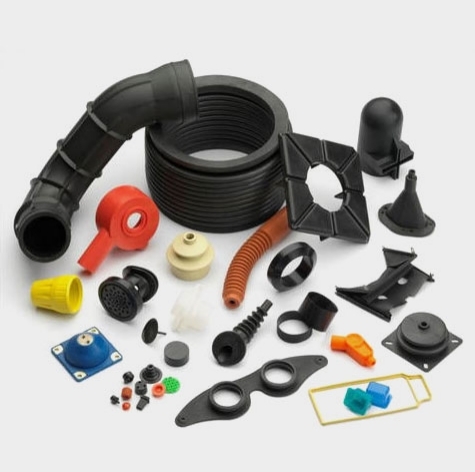Silicone rubber is an elastomer (rubber-like material) composed of silicone—itself a polymer—containing silicon together with carbon, hydrogen, and oxygen. Silicone rubbers are widely used in industry, and there are multiple formulations. Silicone rubbers are often one- or two-part polymers, and may contain fillers to improve properties or reduce cost.
Silicone rubber is generally non-reactive, stable, and resistant to extreme environments and temperatures from −55 to 300 °C (−70 to 570 °F) while still maintaining its useful properties. Due to these properties and its ease of manufacturing and shaping, silicone rubber can be found in a wide variety of products, including voltage line insulators; automotive applications; cooking, baking, and food storage products; apparel such as undergarments, sportswear, and footwear; electronics; medical devices and implants; and in home repair and hardware, in products such as silicone sealants.

If you are curious about how you might use silicone rubber, it pays to know a few things about it first. We’ve covered the most fascinating facts here, but there are many more, delving into various areas such as its ability to withstand extremes of temperature.
How many of these things did you already know?
It is a versatile material
Many people are surprised to learn how many silicone rubber parts there are in the world around them. Oftentimes you won’t see these parts, as they form an integral yet unseen part of the item using them. However, you can be sure the item won’t work as long or as efficiently without them. And that’s because…
It lasts far longer than standard rubber
Silicone rubber is known for its longer lifespan. If all other things are equal, silicone rubber can outlive standard rubber parts several times over. This alone is one of the most important reasons why manufacturers choose it when developing their products and choosing the best parts to use.
It doesn’t degrade like normal rubber
Rubber begins to degrade from the moment the product using it is made. This doesn’t happen with the silicone alternative. While silicone rubber can eventually fail, it tends to do so visibly, thereby making it easy to identify the issue and get a replacement part. With rubber parts, microscopic splits or holes can develop and cause issues even before you realise what has happened.
Plenty of industries use it
You can see how versatile silicone is, so it won’t come as a surprise to learn that it crops up in many industries. Many parts of an airplane can be made of silicone thanks to the reliability we highlighted earlier. You may have used silicone baking moulds and been able to twist them when taking them out of the oven to get the baked goods out with ease.
Other people rely on them to safely deliver fluids to people in hospital, as silicone is used for tubing. The smooth surface means the tubing stays clean and hygienic throughout its use. Many of the properties of this type of rubber make it the smart choice for safety, efficiency, cleanliness, and reliability in lots of different ways.
It can be used as part of a product or as the whole thing
For example, silicone rubber washers and gaskets are often used in products that need those items – think of cars and machinery among other things. However, we can also use silicone rubber on its own. Many cooking utensils, baking dishes, and cupcake trays are made from this material as it withstands heat and holds its shape well.
The more you know about the properties and powers of silicone, the easier it is to realise how it might benefit your business. Many product lines are made stronger by the inclusion of silicone over standard rubber, whether it means adding parts or making the entire product from silicone. In all cases, you’re looking at a great product.
